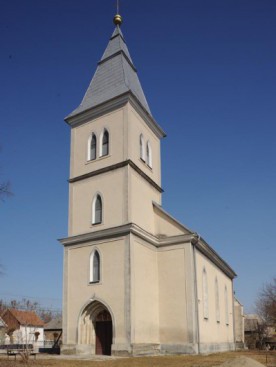The Roman Catholic Church –ChornotysivThis village situated on the Ugocsa plain was inhabited by royal forest rangers at the end of the 13th century. Initially, it was part of the Nyalábvár castle estate, but was acquired by the Perényi family later. The congregation converted to Calvinist faith in the 16th century, but the church was returned to the Catholics in 1754. The church started to decay later: the roof structure of the nave was destroyed and the sanctuary remained the single usable part of the building. The bishop of Szatmár had it restored in the 19th century and, in consequence, the church preserved its medieval shape to a large extent. According to earlier opinions, the semi-circular sanctuary was built in the 13th century, however, it is more likely that this part stems from the or 14th century. In this respect, the late Gothic style window proves that the sanctuary was rebuilt. Similarly, the nave had been built probably in the 14th century, while the tower may be of the same age since old photographs show that both elements were built of broken stone and their corners were decorated with carved quoin stones. The dominant element of the frontispiece is the western portal spanned by a deep archivolt. The most important attractions inside the church are the frescoes on the nave’s northern wall, which were discovered and restored by Ferenc Springer. The right hand side image of the upper register shows four persons, but their heads were already missing in the 19th century. Presumably, the people in question are Saint Paul, Saint John the Baptist and Christ standing in the river Jordan. Next to this painting and to the chancel arch, there is a larger – unfortunately badly damaged – picture showing how Saint Peter sank while walking upon the Lake of Gennesareth. The lower register contains five representations. To the left, the artist painted Saint Helena and The Holy Family with their relatives, but only the head of the empress with a detail of the cross as well as the head and torso of Mary of Clopas were preserved, respectively. The next painting is a composition presenting two saints: Saint Agnes and king Saint Louis of France. The painting to the right had been destroyed totally, but the last one – next to the chancel arch – has been preserved. On the left hand side of this fifth picture, The Holy Mary sits on her throne with the baby Jesus in her lap; king Saint Ladislaus kneels in front of them and above his head a flying angel holds a crown. This motif, i. e. the crowning of the king by the Lord’s angel, is extremely rare, though a similar depiction can be seen on the nave’s wall in the church of Baktalórántháza. |
















